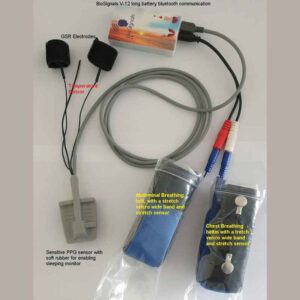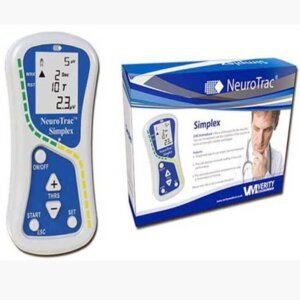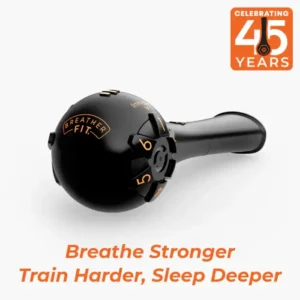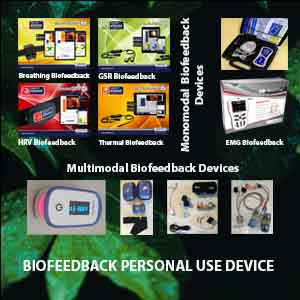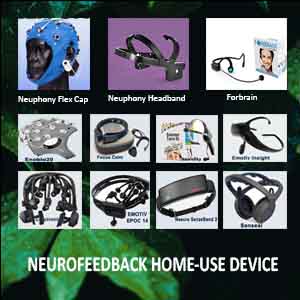
Peak and Optimal Performance Biofeedback
It is expected to think of body function being altered only by external agents such as medications or surgery or physical activities such as exercise or massage. However, we each can regulate our physiology to a far greater extent than is generally known, reach optimal performance in any sphere of life, and get professional peak performance. To be able to do this, it is necessary to see, understand, and manage the physiological parameters of our body.
This becomes possible with biofeedback training/therapy technology – a procedure in which biological information is measured from an individual’s body and presented (“fed back”) to the individual. Several Biofeedback techniques may be used to gather information about an individual’s bodily responses to pathological states and disorders treatment and to bring the individual’s physiological parameters to the level that will allow peak performance in any sphere of life.
Table of Contents
Toggle- Peak and Optimal Performance Biofeedback
- What is Peak Performance?
- What is the difference between peak performance and optimal performance?
- The Role of peak performance and optimal performance in professional success
- The role of biofeedback in optimal/peak performance development
- Role of Attention, Concentration and Memory in optimal/peak performance and professional success
- What modality of biofeedback is best for optimal performance for various specialties and professions?
- How different modalities of biofeedback can support peak performance?
- Which of biofeedback modalities can be used in various professions for peak & optimal performance?
- FAQ: Peak and Optimal Performance
- Biofeedback Home Use Device
What is Peak Performance?
Peak Performance describes an individually based development and mentoring approach that aims to enhance individuals’ performance in various spheres of life, including education, professional, business, and sports. It is about playing life at the highest possible level and reaching our fullest potential.
Peak performance is a state of optimal functioning in which an individual performs at their highest level, both physically and mentally. It is a state of flow in which an individual is fully immersed in the task at hand, and their abilities are aligned with the task’s demands. In this state, individuals can achieve their best performance, often exceeding their previous personal bests.
Peak performance can be achieved in various fields, including sports, business, the arts, academics, etc. It is characterized by a combination of factors, including high levels of motivation, focus, skill, and resilience. Achieving peak performance requires a holistic approach that includes physical, mental, and emotional preparation and proper training, nutrition, and rest.
Overall, peak performance is a state of excellence in which individuals can achieve their highest potential and perform at their best. It is a highly sought-after state that requires consistent effort and dedication.
What is the difference between peak performance and optimal performance?
Peak and optimal performances are often used interchangeably, but there is a subtle difference between the two.
Peak performance refers to a temporary state of optimal functioning where an individual performs at their highest level, often exceeding their previous personal bests. Specifically, it is a state of flow where an individual is fully immersed in the task at hand, and their abilities are aligned with the task’s demands.
On the other hand, optimal performance refers to a sustained state of optimal functioning where an individual consistently performs at a high level over an extended period. It is characterized by a combination of factors, including high levels of motivation, focus, skill, and resilience, and requires ongoing effort and dedication.
In summary, while peak performance is a temporary state of optimal functioning achieved in a particular moment, optimal performance is sustained through ongoing effort and dedication.
Here are some examples to help you understand the difference between peak performance and optimal performance relative to certain specialties.
Example 1. Peak performance for singers
Peak performance for singers refers to a temporary state of optimal functioning where they perform at their highest level during a particular performance or recording session. They are fully immersed in their singing and able to deliver their best performance, often exceeding their previous personal bests.
On the other hand, optimal performance for singers refers to a sustained state of optimal functioning where they consistently perform at a high level over a more extended period. It requires ongoing effort and dedication, including proper vocal training, regular practice, healthy nutrition, and sufficient rest.
To achieve peak performance, singers must focus on developing their vocal skills, including breath control, pitch accuracy, tone quality, and range. They must also have a good stage presence, connect with their audience, and deliver a captivating performance. They should also prioritize proper vocal health, including warm-up and cool-down exercises, and avoiding behaviors that can damage their vocal cords, such as smoking or excessive alcohol consumption.
To achieve optimal performance, singers must maintain their vocal health and regularly practice to refine their skills. They should also focus on building their repertoire, performing regularly, and seeking opportunities to collaborate with other musicians and expand their horizons.
Overall, achieving peak and optimal performance as a singer requires a holistic approach that includes physical and mental preparation, consistent effort, and dedication.
Example 2. Peak and optimal performance for surgeons
Peak and optimal performance for surgeons are critical for ensuring the best possible outcomes for patients. Surgeons must have the physical and mental capacity to perform intricate surgical procedures requiring high skill and attention to detail.
Peak performance for surgeons involves being at the top of their game physically and mentally during the surgical procedure. Surgeons must be able to perform the surgery with precision and accuracy while also managing any unexpected situations that may arise during the operation. This requires a high level of focus, concentration, and physical agility.
Optimal performance for surgeons, on the other hand, refers to a sustained state of optimal functioning and involves consistently performing at a high level over an extended period. Surgeons need to maintain their physical and mental stamina over long periods to ensure they can perform complex surgeries with minimal errors. This requires a combination of physical fitness, mental toughness, and the ability to manage stress and fatigue. It requires ongoing effort and dedication, including proper surgical training, regular practice, healthy lifestyle habits, and continuous education.
To achieve optimal performance, surgeons must prioritize their physical and mental health, including proper nutrition, regular exercise, and sufficient rest. They must also maintain their surgical skills, regularly practice surgical techniques, and stay up-to-date with new developments in their field. They should also seek opportunities to collaborate with other medical professionals and participate in continuing education courses to expand their knowledge and skills.
The Role of peak performance and optimal performance in professional success
Both peak and optimal performance are essential for professional success and can complement each other.
Peak performance refers to achieving the highest performance at a particular moment, while optimal performance refers to consistently performing at a high level over time.
While achieving peak performance can be impressive and help individuals stand out in their field, it is not sustainable over the long term. Optimal performance, on the other hand, is more important for sustained career success. Consistently performing at a high level over time requires focusing on factors such as self-care, work-life balance, and continuous learning and development.
In essence, peak performance can be thought of as a short-term goal, while optimal performance is a long-term goal. Both are important, but optimal performance is critical for long-term success and career longevity.
The role of biofeedback in optimal/peak performance development
Biofeedback can play an essential role in developing optimal/peak performance by providing individuals with real-time information about their physiological processes and helping them learn to control these processes to achieve optimal/peak performance.
One of the main ways that biofeedback can aid in developing optimal/peak performance is by helping individuals learn to regulate their stress response. Indeed, excessive stress can interfere with attention, concentration, and decision-making, making it challenging to perform at one’s best. However, by learning to recognize and control their physiological response to stress using biofeedback, individuals can reduce the negative impact of stress on their performance.
Additionally, biofeedback can help individuals learn to regulate their breathing, heart rate, and other critical physiological processes for optimal/peak performance. For example, in sports, optimal performance requires a state of physical and mental arousal that is neither too high nor too low. Biofeedback can help athletes learn to regulate their breathing and heart rate to achieve this optimal level of arousal.
Biofeedback can also help individuals improve their focus and attention, which is essential for optimal/peak performance in many professions. For example, surgeons must maintain focus and attention for long periods to perform complex procedures with precision and accuracy.
Finally, biofeedback can help individuals develop greater self-awareness and mindfulness, improving their ability to regulate emotions and maintain a positive mindset even in high-pressure situations.
Thus, biofeedback can be a valuable tool for individuals seeking optimal/peak performance. It helps them regulate their stress response, improve their focus and attention, and develop greater self-awareness and mindfulness.
How biofeedback helps to reach optimal/peak performance
- Stress reduction: Chronic stress can lead to burnout and decreased performance. Biofeedback techniques such as heart rate variability and breathing can help individuals learn to regulate their stress response, improving cognitive function and overall performance.
- Attention and focus: Neurofeedback and EEG biofeedback can help individuals improve their attention and focus, critical skills for optimal performance in many professions.
- Physical performance: EMG biofeedback can help individuals improve their muscle activation and control, leading to better physical performance.
- Sleep quality is essential for optimal performance, and sleep disturbances can negatively impact performance. Temperature and EEG biofeedback can help individuals improve their sleep quality, leading to better overall performance.
- Cognitive function: Neurofeedback can help individuals enhance their cognitive function, including memory and processing speed, which are crucial for optimal performance in many professions.
By utilizing biofeedback techniques to enhance physiological responses, individuals can optimize their performance and achieve their professional objectives. However, it is essential to note that biofeedback is not a magic solution and requires consistent practice and effort to achieve the best results.
Role of Attention, Concentration and Memory in optimal/peak performance and professional success
Attention, concentration, and memory are essential cognitive skills for optimal/peak performance and professional success. These skills are closely related and interdependent, and their efficient functioning is required for individuals to perform at their best in their respective fields.
Attention is focusing on specific information while selectively ignoring irrelevant information. It is a crucial factor in maintaining high levels of concentration, which is the ability to focus on one particular task for a prolonged period. On the other hand, memory involves retaining and recalling information from past experiences and learning.
In many professions, such as medicine, law, and engineering, optimal performance requires individuals to maintain high attention and concentration. Surgeons, for example, need to maintain high concentration and attention to detail during surgical procedures to ensure patient safety.
Different modalities biofeedback
Biofeedback can improve attention, concentration, and memory by providing real-time feedback on physiological processes related to these cognitive skills. For example, neurofeedback can train the brain to maintain a state of focused attention and concentration by providing input on brainwave patterns. This can be particularly helpful for individuals who struggle with attention deficit disorder (ADD) or attention deficit hyperactivity disorder (ADHD).
Similarly, heart rate variability biofeedback can improve concentration and memory by training individuals to regulate their stress response. Individuals can improve their ability to focus and remember important information by reducing stress levels.
Breathing biofeedback can also improve attention, concentration, and memory by training individuals to regulate their breathing patterns. By improving breathing patterns, individuals can enhance their oxygenation levels and reduce stress, improving cognitive performance.
Biofeedback can be used to train and improve these skills by providing real-time feedback on physiological processes related to cognitive performance. By using biofeedback techniques, individuals can learn to regulate their mental processes and enhance their performance in their respective fields.
What modality of biofeedback is best for optimal performance for various specialties and professions?
The best modality of biofeedback for optimal performance depends on the specific needs of each profession and individual. Here are some examples of how different modalities of biofeedback can be used to achieve optimal performance in various specialties:
- Surgeons: EMG biofeedback can help surgeons improve their muscle activation and control during procedures, leading to better surgical outcomes.
- Musicians: Neurofeedback can help musicians improve their focus and concentration, leading to improved performance.
- Athletes: Heart rate variability biofeedback can be beneficial for athletes in regulating their stress response and improving their physical performance.
- Business professionals: EEG biofeedback can help business professionals improve their cognitive function and decision-making abilities.
- Students: Temperature biofeedback can be helpful for students, leading to improved academic performance.
It’s important to note that these are just a few examples, and the best modality of biofeedback for optimal performance will vary based on individual needs and goals. Working with a qualified biofeedback practitioner can help individuals identify the most effective modality for their situation.
How different modalities of biofeedback can support peak performance?
HRV Biofeedback
1. Enhances Stress Management:
HRV biofeedback can improve stress management by teaching individuals how to regulate their physiological stress response. This skill can be especially useful for individuals in high-stress professions, such as athletes, executives, and first responders.
2. Improves Emotional Regulation:
HRV biofeedback can help individuals regulate their emotions by improving their ability to shift from reactive to more balanced and relaxed states. This can benefit performers like musicians, actors, and public speakers, who must manage their emotions while on stage.
3. Increases Resilience:
HRV biofeedback can improve resilience by teaching individuals how to recover quickly from stress and adversity. This can be useful for individuals in professions like healthcare, where they are exposed to high levels of stress and trauma.
4. Enhances Cognitive Function:
HRV biofeedback can improve cognitive function by improving blood flow to the brain and increasing neural connectivity. This can be useful for professionals like scientists, researchers, and educators who need to maintain high mental focus and creativity.
5. Improves Sleep Quality:
HRV biofeedback can improve sleep quality by helping individuals regulate their sleep patterns and promote relaxation. This can benefit individuals in professions like pilots, truck drivers, and shift workers who must maintain a consistent sleep schedule to perform optimally.
Breathing Biofeedback
1. Reducing stress:
Learning to control and slow down breathing rates can activate the parasympathetic nervous system and reduce stress levels. This can help improve mental clarity and focus, essential for peak performance.
2. Enhancing physical performance:
By practicing controlled breathing, individuals can improve oxygenation and carbon dioxide elimination, which can help increase physical endurance and performance. This can be particularly beneficial for athletes and performers.
3. Improving emotional regulation:
By practicing breathing techniques, individuals can learn to regulate their emotions and reduce anxiety and negative emotions. This can help improve decision-making and problem-solving abilities, essential for peak performance.
4. Improving cognitive function:
Breathing techniques can also improve cognitive function, including attention, concentration, and memory. Individuals can enhance cognitive performance and achieve optimal performance by reducing stress and increasing oxygenation to the brain.
5. Improving sleep:
Breathing techniques can also help improve sleep quality and quantity, which is essential for peak performance. By reducing stress and promoting relaxation, individuals can improve their sleep and wake up refreshed and energized.
EMG Biofeedback
1. Stress and anxiety management:
EMG biofeedback of the stress muscles can help individuals learn to control and reduce muscle tension, which can be crucial in reducing stress and anxiety levels.
2. Injury prevention and rehabilitation:
By monitoring and learning to control muscle tension and relaxation, individuals can use EMG biofeedback to help prevent and recover from injuries related to muscle imbalances, overuse, or muscle tension.
3. Athletic performance:
EMG biofeedback can help athletes learn to activate specific muscle groups more efficiently and effectively, improving overall performance and reducing the risk of injury.
4. Posture improvement:
EMG biofeedback can help individuals improve their posture by teaching them to activate and relax specific muscle groups in the back, shoulders, and neck.
5. Chronic pain management:
EMG biofeedback can be a useful tool for individuals dealing with chronic pain. It can help them learn to control muscle tension and reduce pain levels.
Thermal Biofeedback
1. Stress reduction:
Temperature biofeedback can reduce stress and anxiety levels, as increased stress and anxiety can decrease body temperature. By learning how to regulate body temperature through biofeedback, individuals can effectively manage stress and improve their overall mental and physical well-being.
2. Pain management:
Temperature biofeedback can also be used for pain management. It is effective in reducing pain levels for individuals with chronic pain conditions such as fibromyalgia and migraines. Individuals can effectively manage their pain levels by learning how to increase body temperature in specific areas.
3. Relaxation:
Temperature biofeedback can be used to induce a state of relaxation by increasing skin temperature, which can promote feelings of calm and tranquility. By learning how to control their body temperature, individuals can induce a state of relaxation and reduce feelings of stress and anxiety.
4. Improved sleep:
Temperature biofeedback can also improve sleep quality, as a decrease in body temperature is associated with the onset of sleep. By learning how to regulate their body temperature through biofeedback, individuals can improve their sleep quality and wake up refreshed and energized.
5. Focus and concentration:
By using temperature biofeedback, individuals can learn to control blood flow and temperature to specific body parts, enhancing focus and concentration. For example, increasing blood flow to the brain can improve mental clarity and focus.
6. Regulation of body temperature:
Temperature biofeedback can help individuals regulate their body temperature, essential for optimal performance in many activities. For example, athletes can use temperature biofeedback to maintain optimal body temperature during training and competition.
EDSA Biofeedback
1. Stress management:
EDA biofeedback can help individuals learn to recognize and manage stress levels by providing real-time feedback on their skin conductance levels. By learning to manage stress levels, individuals can enhance their performance and reduce the negative impact of stress on their health.
2. Emotional regulation:
EDA biofeedback can also help individuals regulate their emotions. It has been used to help individuals with anxiety disorders, phobias, and post-traumatic stress disorder (PTSD) learn to regulate their emotional responses and improve their overall psychological functioning.
3. Attention and focus:
EDA biofeedback can help individuals improve their attention and focus. Individuals can enhance their ability to concentrate and maintain attention over extended periods by learning to regulate their arousal levels.
4. Performance enhancement:
EDA biofeedback can enhance performance in various domains, including sports, music, and public speaking. Individuals can enhance their performance and achieve their optimal potential by learning to regulate their physiological responses.
5. Health and wellness:
EDA biofeedback can also improve overall health and wellness. By learning to manage stress levels and regulate their physiological responses, individuals can improve their physical and mental health and reduce the risk of various health problems, such as cardiovascular disease and depression.
6. Anxiety and Phobia Management:
EDA biofeedback can be used to help individuals manage anxiety and phobias. By providing real-time feedback on the electrical conductance of the skin, individuals can learn to manage their anxiety levels and desensitize themselves to phobias.
Neurofeedback
1. Enhancing focus and concentration:
Neurofeedback can help improve focus and concentration by training the brain to produce more alpha and beta waves associated with attentive states.
2. Improving memory:
Neurofeedback can help improve memory by increasing the production of theta waves, which are associated with learning and memory consolidation.
3. Reducing stress and anxiety:
Neurofeedback can help reduce stress and anxiety by training the brain to produce more alpha and fewer beta waves associated with relaxation and calmness.
4. Improving sleep:
Neurofeedback can help improve sleep by training the brain to produce more delta waves associated with deep, restorative sleep.
5. Enhancing creativity and problem-solving:
Neurofeedback can help enhance creativity and problem-solving by training the brain to produce more alpha and theta waves associated with creative thinking and insight.
Which of biofeedback modalities can be used in various professions for peak & optimal performance?
Heart rate variability (HRV) biofeedback
HRV biofeedback can help improve emotional regulation, stress management, and cognitive function, which is essential for peak performance in various professions, including athletics, medicine, and business. For example, athletes can use HRV biofeedback to manage stress, increase focus, and improve performance. HRV biofeedback can manage anxiety and stress in medicine, leading to better decision-making and patient outcomes. HRV biofeedback can help executives manage stress and improve their decision-making abilities in business.
Breathing biofeedback
Breathing biofeedback can help improve focus, attention, and relaxation, which is essential for peak performance in various professions. For example, breathing biofeedback can help musicians improve their performance by teaching them how to control their breathing to reduce anxiety and improve focus. In law enforcement, breathing biofeedback can help officers manage stress and stay calm in high-pressure situations. In medicine, breathing biofeedback can help patients manage chronic pain and anxiety.
EMG biofeedback
EMG biofeedback can help improve muscle relaxation and reduce muscle tension, essential for peak performance in various professions. For example, EMG biofeedback can help surgeons improve their performance by teaching them how to relax their muscles during long surgeries to reduce fatigue. EMG biofeedback is often used in physical therapy to help patients with muscle tension, pain, and weakness. Moreover, athletes can use EMG biofeedback to improve their muscle control and reduce the risk of injury. In dentistry, EMG biofeedback can help patients with temporomandibular joint (TMJ) disorders improve their jaw muscle function.
Temperature biofeedback
Temperature biofeedback can help improve blood flow and reduce stress, essential for peak performance in various professions. For example, it can help public speakers improve their performance by teaching them how to regulate their body temperature to reduce anxiety and improve focus.
Electroencephalogram (EEG) biofeedback
Neurofeedback can help improve cognitive function, memory, and attention, which is essential for peak performance in various professions. Neurofeedback is commonly used in sports, education, and healthcare. Athletes can use EEG biofeedback to improve focus, attention, and reaction time. In education, EEG biofeedback can help students with ADHD or other learning disabilities improve their focus and academic performance. In healthcare, EEG biofeedback can be used to treat a variety of conditions, including anxiety, depression, and chronic pain. Neurofeedback can help executives improve decision-making skills by training their brains to stay focused and alert during long meetings.
Galvanic skin response (GSR) biofeedback
GSR biofeedback can be used in various professions, including business, healthcare, and law enforcement. It can help executives manage stress and improve their decision-making abilities in business. GSR biofeedback can treat anxiety disorders and chronic pain and help in healthcare. In law enforcement, it can help officers manage stress and stay calm in high-pressure situations.
Different biofeedback modalities can improve various aspects of peak and optimal performance in other professions by enhancing individuals’ ability to regulate their physiological responses to stress and pressure. This leads to improved cognitive function, memory, attention, and relaxation. The selection of the best modality depends on each individual’s specific needs and goals.
FAQ: Peak and Optimal Performance
Peak performance refers to performing at your highest possible level in a specific task or activity, often characterized by exceptional focus, efficiency, and skill. It is typically associated with short-term, high-intensity achievements, such as athletic competitions, public speaking, or critical professional tasks.
Optimal performance is a balanced and sustainable state in which you consistently perform well over time without burnout.
Peak performance, on the other hand, is a short-term, high-intensity state that pushes your limits for maximum output.
Biofeedback enhances peak performance by increasing awareness and control over physiological functions such as heart rate, brainwave activity, breathing, and muscle tension. Through regular training, you learn to enter focused, calm, and high-performance states on demand, reducing stress, sharpening focus, and optimizing mental and physical readiness.
The most effective types of biofeedback for achieving peak and optimal performance include:
- Neurofeedback for improving focus, memory, and mental clarity
- Heart Rate Variability (HRV) biofeedback for stress regulation and emotional resilience
- EMG biofeedback for muscle control and faster physical recovery
- Breath biofeedback for enhancing endurance and calm under pressure
Each modality supports different aspects of performance, and combining them can produce even greater results.
- Athletes – For improved focus, endurance, and recovery.
- Professionals & Executives – To enhance decision-making, creativity, and stress management.
- Performers (Musicians, Actors, Speakers) – To reduce stage fright and boost confidence.
- Students – For better concentration and test-taking performance.
Results vary, but most people notice improvements within 4-8 weeks of consistent training.










